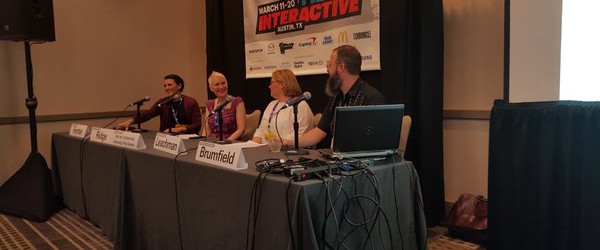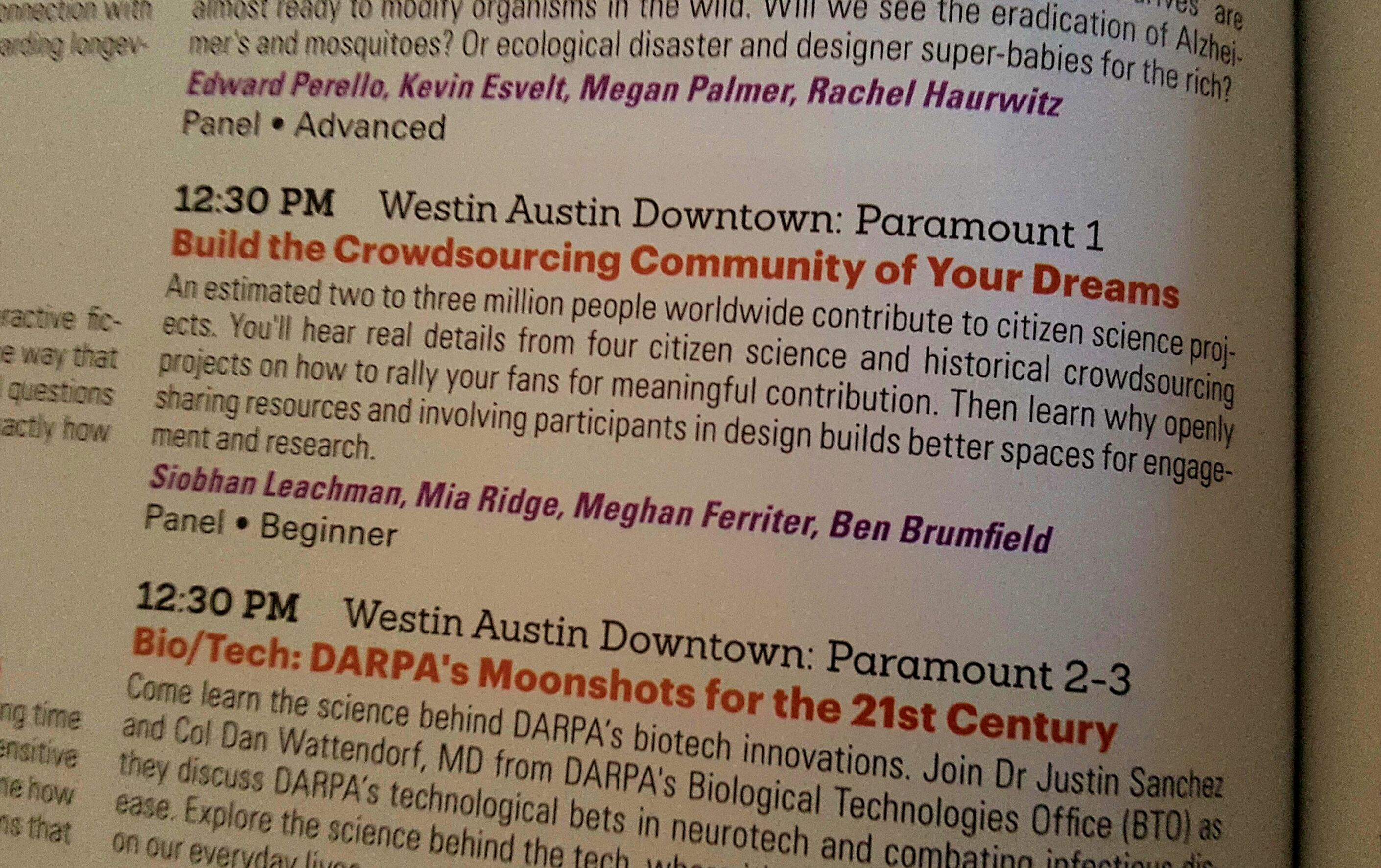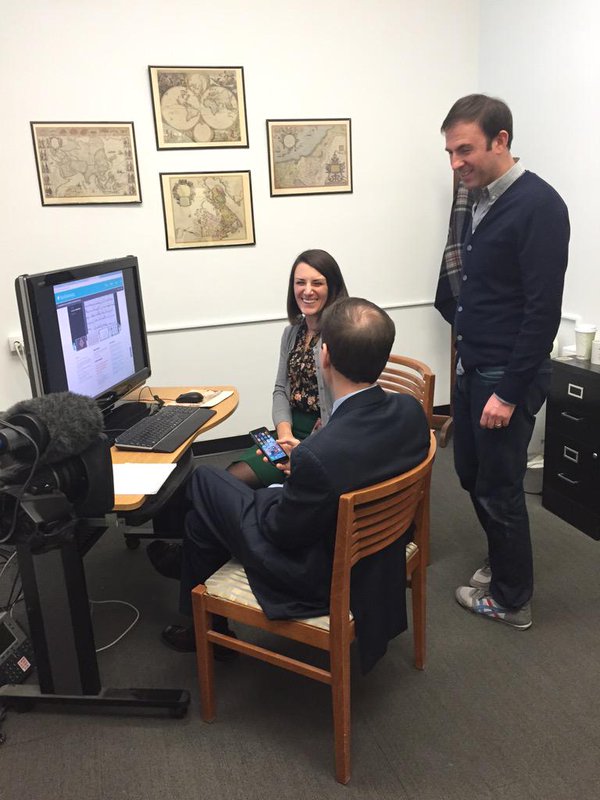Day: April 4, 2016
Dreamy Digital Engagement at SXSW Interactive

At SXSW Interactive, I was on the trail of engagement, interaction, communication, and online collaboration – from opening sessions to my crowdsourcing panel on 12 March and beyond.
In November 2015, I was frankly pumped to have my panel on building engaged communities through crowdsourced transcription accepted for SXSW Interactive. The panel we submitted included three forward-thinking, complimentary mindsets with unique views into the challenges and complexities of crowdsourcing: digital curator Dr. Mia Ridge and independent software developer Ben Brumfield and long-time Citizen Scientist and self-identified #volunpeer Siobhan Leachman.
 When March 2016 arrived, I was well past thrilled – but also focused on making our panel useful and engaging, even as we discussed approaches for engagement. We arranged our session as a brief introductory round robin, a series of discussion prompts, and open discussion – finalized over pretty delicious brats and brews at Easy Tiger. Mmm, “brain food.” We also gathered useful resources for getting up to speed on our discussion and shared them along with our panel slides.
When March 2016 arrived, I was well past thrilled – but also focused on making our panel useful and engaging, even as we discussed approaches for engagement. We arranged our session as a brief introductory round robin, a series of discussion prompts, and open discussion – finalized over pretty delicious brats and brews at Easy Tiger. Mmm, “brain food.” We also gathered useful resources for getting up to speed on our discussion and shared them along with our panel slides.
On Saturday, March 12, during our standing-room only session, we had observations and direct questions with a practical bent. Specifically we heard questions about tried-and-true tactics for recruiting and retaining participants (lifecycle of participants). We were able to reflect on our approaches, as well as what we might do as best practice. We were also asked about the ways crowdsourcing can be integrated as more of a “win” such as being acknowledged as a credited volunteer contribution. We also were asked what we viewed on the horizon for crowdsourcing. Mia is concerned with machine learning and leveling up human computation, Siobhan is most interested in the connections between the data, while Ben is focused on the mobile writing on the wall. I’m interested in all of those things, but also maintaining supportive spaces + using the data + new tasks such as audio transcription and image-based decision trees (for the TC). Finally we also had queries about the potential to integrate crowdsourcing into the classroom. We offered smaller examples of integration in secondary and primary schools, as well as with regard to life-long learning. Siobhan rounded up the commentary in this storify.
As I wrote elsewhere in our bid for selection: “The most important element of our panel is passion – it will become clear to you if when we’re selected that we aren’t merely advocates for the power of many hands making light work. Rather we want to make those tools, projects, and experiences the very best they can be. We also support openly sharing best practice and the product whenever possible.” It was a pleasure to convene with Siobhan, Ben, and Mia. Check in with Mia’s round up of our panel at SXSW.
Are you thinking about what’s next for crowdsourcing? Join us in Krakow at DH2016 on 12 June to sight the terrain that lies ahead for crowdsourcing. You can apply and learn more about our goals for a collaborative session here.
Watch this space for my round up of the rest of the sessions I attended at SXSW: including but not limited to”posts that disappear,” seeding entrepreneurial cities, misguided understandings of participation barriers.
Featured Image via Mike Killi’s tweet – thanks for spending the session with us, Mike!
CBS This Morning: Up close and Digital

I came across this tweet earlier today and recalled the bit of time I spent with the CBS This Morning team in February 2015.
Hey #volunpeers here's @MeghaninMotion about to give an interview with @CBSThisMorning about @TranscribeSI pic.twitter.com/VYgCjNCAtR
— Sarah Sulick (@sarahtsulick) February 5, 2015
 Looks like I forgot to share about this 15 seconds of fame when it happened! In all seriousness, it was a brilliant opportunity to tell a wider audience about the innovative efforts of the Digitization Program Office, the 3D and Digitization teams, and OCIO’s support of Smithsonian Transcription Center.
Looks like I forgot to share about this 15 seconds of fame when it happened! In all seriousness, it was a brilliant opportunity to tell a wider audience about the innovative efforts of the Digitization Program Office, the 3D and Digitization teams, and OCIO’s support of Smithsonian Transcription Center.
So, on that Thursday, at the National Museum of American History, I demonstrated the varying projects in the Smithsonian Transcription Center (TC). Then we checked in on the National Numismatics Collection mass digitization project on the conveyor belt. After that, I chatted on camera for a few minutes with Mark Albert about the promise of crowdsourcing.
Not in the final video edit: I also explained the benefits and potential of making knowledge more accessible in collaborative ways. I described some of our discoveries so far and how the TC fits into other digitization practices at the Smithsonian.
The piece aired on 07 February 2015 as “3D imaging takes Smithsonian from Washington to the world.”
Be sure to watch for an apt reflection on digitization and access from former Digitization Program Office Director Günter Waibel at 3:18 (right before my bumble bee tour). Günter’s final quote closing the clip underscored the ways that these efforts match the vision of James Smithson: “He understood that when information is shared, science gets better.”
I’m looking forward to sharing more updates soon on the ways SI staff, volunteers, and the TC’s mechanisms are increasing the capability for information to be shared easily – and in turn, improve understandings of history, culture, and art, as well as science.
